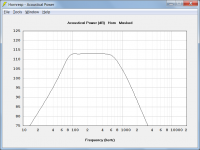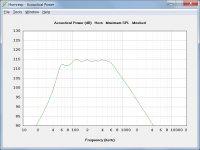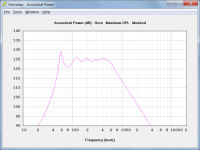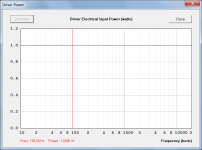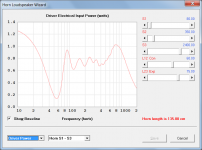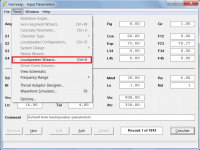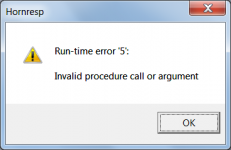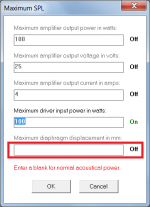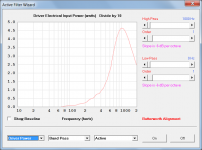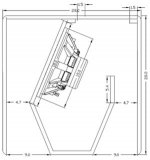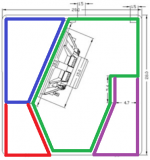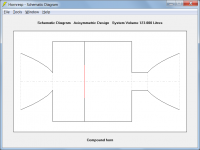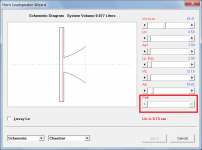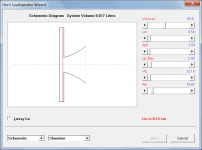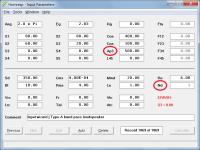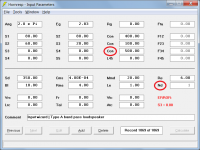If however you looked at the model using constant power rather than constant voltage, the resulting SPL response will definitely not be flat.
For the default record:
Attachment 1 shows the constant voltage (2.83V) response.
Attachment 2 shows the constant power (1W) response.
Attachment 3 shows the constant current (1A) response.
due to the varying impedance through the passband, the calculated wattage will also vary across the passband.
Because a constant power source is being used, the wattage stays the same regardless of the varying impedance, as shown in Attachment 4. The input current and voltage will however vary.
I = (P / Z) ^ 0.5 amps
V = (P * Z) ^ 0.5 volts
Where P is constant and Z is varying.
Hornresp's models default to modeling with a constant voltage source, "Eg". I'm not aware of an option that allows one to model with a constant power source.
As indicated in Post #12482, the Maximum SPL tool can be used to specify a constant power source. A constant current source can be specified instead if required, as shown in Attachment 3.
Attachments
I believe Bjorn Kolbrek is a member here if you’d like to take it up with him? I’d like to think that he and David have a long-running friendship, given the citation in Kolbrek’s earlier thesis papers and general tone of writing.
I've corresponded with David since 2004, and he has helped me out a lot. I hope I have been of some use to him as well 🙂 At least he got a complimentary copy of the book...
They’re very much companion pieces, in my mind.
Yes, I hope the book can improve people's understanding of what Hornresp does, and that Hornresp can help people grasp the theory in the book.
I hope I have been of some use to him as well 🙂
Without question!
I've corresponded with David since 2004, and he has helped me out a lot. I hope I have been of some use to him as well 🙂 At least he got a complimentary copy of the book...
Yes, I hope the book can improve people's understanding of what Hornresp does, and that Hornresp can help people grasp the theory in the book.
That’s the impression I had, but I didn’t realise it went back so far. Science is better together, like many things 🙂 a copy of the book was really hard to find earlier this year, but I’ve been working through it cover to cover as best I can.
Hornresp has been great to try some things, as is your older MPM toolbox code and bits of the Akabak manual, but there’s still a lot of back and forth to correlate the concepts or figure out where some of the ‘hidden maths’ happens. Graphs are great but being able to see ‘behind the curtain’ is the real value; a big lightbulb moment was seeing the IP2 algorithm from David in the book, at least for me!
I’m keen to have a look at this third-party PDF that David linked earlier in this thread:
Hi Everyone,
A Hornresp user in Sweden has produced a very comprehensive 170 page "Hornresp Manual" that you may find of interest. The PDF file can be downloaded from:
The author, Harald Karlsson, has obviously gone to a lot of trouble to produce the document, and he is to be congratulated on his efforts - very impressive indeed!
Kind regards,
David
Unfortunately it appears to be locked to members of that group and by proxy, Facebook users. As someone who deleted their account some time ago, is it possible to access it some other way?
Thanks to all of you for sharing so much knowledge in this field over such a long period!
Last edited:
That’s the impression I had, but I didn’t realise it went back so far. Science is better together, like many things 🙂 a copy of the book was really hard to find earlier this year, but I’ve been working through it cover to cover as best I can.
We are working on a second printing, with some typos corrected. Should be ready to send to the printer soon, but apparently the lead time is longer now.
Hornresp has been great to try some things, as is your older MPM toolbox code and bits of the Akabak manual, but there’s still a lot of back and forth to correlate the concepts or figure out where some of the ‘hidden maths’ happens. Graphs are great but being able to see ‘behind the curtain’ is the real value; a big lightbulb moment was seeing the IP2 algorithm from David in the book, at least for me!
Being able to test out the equations for yourself can be very useful in understanding things. Playing around with different values and seeing how things change is instructive. Hornresp is very useful for that, but sometimes it is even more instructive to set up everything yourself.
Hornresp Manaual ver 2I’m keen to have a look at this third-party PDF that David linked earlier in this thread:
is it possible to access it some other way?
If anything, I would like to see the VA graph (power vs frequency) in the loudspeaker wizard in Hornresp
If all goes according to plan, it will be added in the next update.
Hornresp Update 5320-211016
Hi Everyone,
CHANGE
A driver electrical input power chart has been added to the Loudspeaker Wizard. In a multiple driver system the power delivered to each driver is shown, rather than the total power delivered to all drivers. Attachment 1 refers.
BUG FIX 1
An unintended consequence of fixing Bug 1 in Post #12452 was that it became possible to select the Loudspeaker Wizard from the default record, leading to a fatal error when the Wizard was closed. Attachments 2 and 3 refer. The Loudspeaker Wizard can no longer be selected from the default record.
BUG FIX 2
The value of an input field in the Maximum SPL tool that did not have the focus became invisible when the parameter was switched from On to Off. Attachment 4 refers. This is no longer the case. The field is disabled but the existing value now remains visible.
Kind regards,
David
Hi Everyone,
CHANGE
A driver electrical input power chart has been added to the Loudspeaker Wizard. In a multiple driver system the power delivered to each driver is shown, rather than the total power delivered to all drivers. Attachment 1 refers.
BUG FIX 1
An unintended consequence of fixing Bug 1 in Post #12452 was that it became possible to select the Loudspeaker Wizard from the default record, leading to a fatal error when the Wizard was closed. Attachments 2 and 3 refer. The Loudspeaker Wizard can no longer be selected from the default record.
BUG FIX 2
The value of an input field in the Maximum SPL tool that did not have the focus became invisible when the parameter was switched from On to Off. Attachment 4 refers. This is no longer the case. The field is disabled but the existing value now remains visible.
Kind regards,
David
Attachments
Installing as I type. Oops. Installed!
New toys just started working on the bandpass wizard. Easy like pie. Thanks David!
New toys just started working on the bandpass wizard. Easy like pie. Thanks David!
If all goes according to plan, it will be added in the next update.
Thanks, could it also be added to the filter wizard?
could it also be added to the filter wizard?
It will require a fair amount of work to implement, but it should be possible. I will try to include something in the next update.
It will require a fair amount of work to implement, but it should be possible. I will try to include something in the next update.
oh, don't worry about it to much 🙂
But much appreciated.
You could perhaps try modelling the design as a compound horn.
Attachment 1:
Use Vrc and Lrc to specify the blue chamber.
Use Vtc and Atc to specify the green chamber (exclude driver volume).
Use segments 1 and 2 to specify the purple port.
Use segment 4 to specify the red port.
Because two sides of the ports are sloping and two (the top and bottom) are parallel, segments 2 and 4 should have Par (parabolic) flares.
Attachments 2 and 3 show an example of the basic design (not to scale).
Attachment 1:
Use Vrc and Lrc to specify the blue chamber.
Use Vtc and Atc to specify the green chamber (exclude driver volume).
Use segments 1 and 2 to specify the purple port.
Use segment 4 to specify the red port.
Because two sides of the ports are sloping and two (the top and bottom) are parallel, segments 2 and 4 should have Par (parabolic) flares.
Attachments 2 and 3 show an example of the basic design (not to scale).
Attachments
Hornresp Update 5320-211031
Hi Everyone,
CHANGE
In some cases the Path slider was being included in the Loudspeaker Wizard even when there was just a single sound output. The Path slider is now only included when there are multiple sound outputs. Attachments 1 and 2 refer.
BUG FIX
The Ap3 label was not being removed when the loudspeaker type was changed from BPA to Nd. This has now been fixed. Attachments 3 and 4 refer.
Kind regards,
David
Hi Everyone,
CHANGE
In some cases the Path slider was being included in the Loudspeaker Wizard even when there was just a single sound output. The Path slider is now only included when there are multiple sound outputs. Attachments 1 and 2 refer.
BUG FIX
The Ap3 label was not being removed when the loudspeaker type was changed from BPA to Nd. This has now been fixed. Attachments 3 and 4 refer.
Kind regards,
David
Attachments
David thanks for getting my thoughts in line for the tapered vent enclosure. I have sone this in the past another way. But what you have shown is much more elegant.
And nice to see the slaying of a few more bugs. One day it will be exactly as you want it!
And nice to see the slaying of a few more bugs. One day it will be exactly as you want it!
- Home
- Loudspeakers
- Subwoofers
- Hornresp
